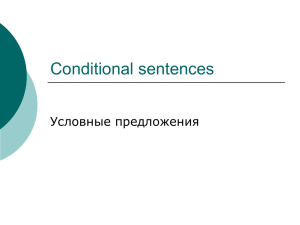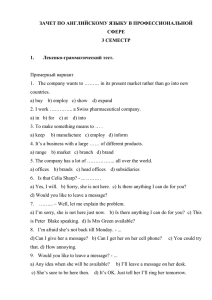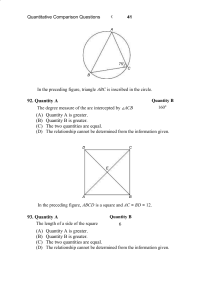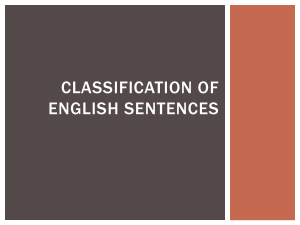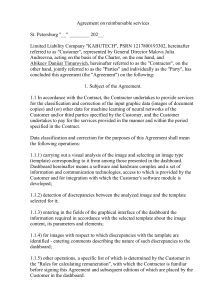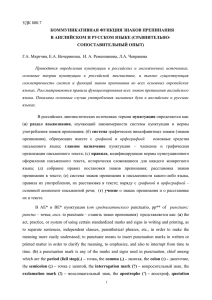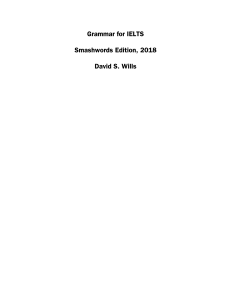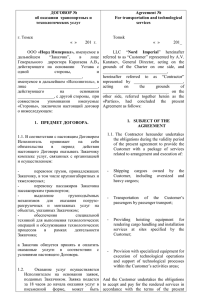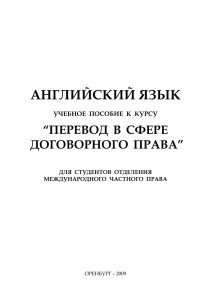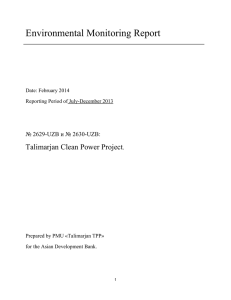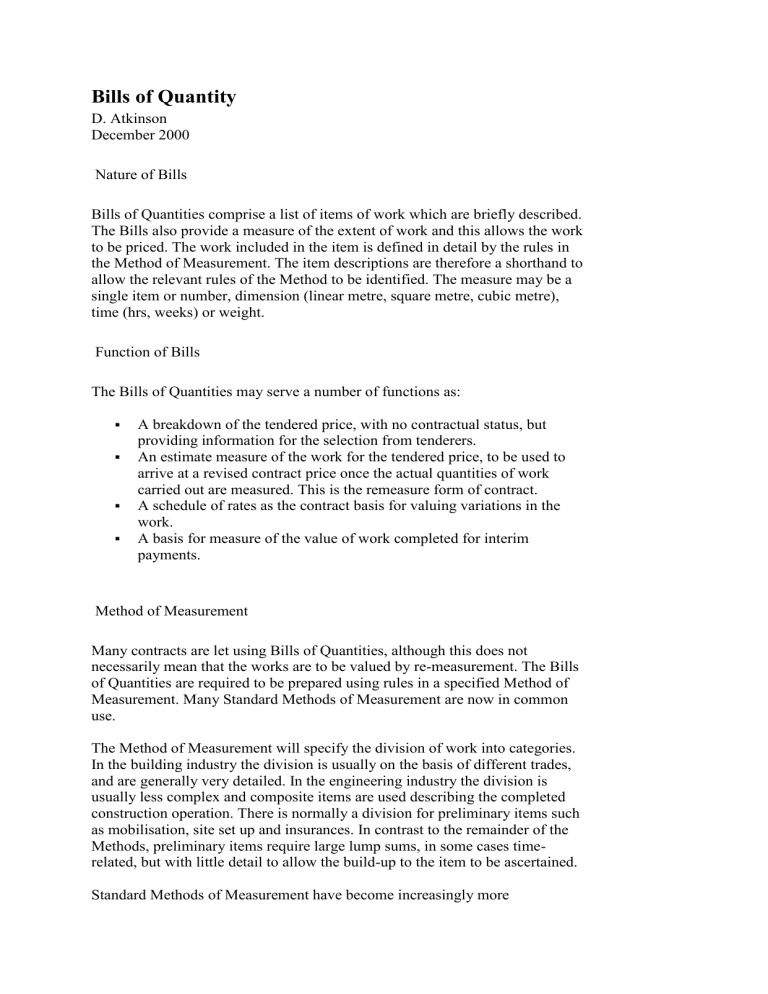
Bills of Quantity D. Atkinson December 2000 Nature of Bills Bills of Quantities comprise a list of items of work which are briefly described. The Bills also provide a measure of the extent of work and this allows the work to be priced. The work included in the item is defined in detail by the rules in the Method of Measurement. The item descriptions are therefore a shorthand to allow the relevant rules of the Method to be identified. The measure may be a single item or number, dimension (linear metre, square metre, cubic metre), time (hrs, weeks) or weight. Function of Bills The Bills of Quantities may serve a number of functions as: A breakdown of the tendered price, with no contractual status, but providing information for the selection from tenderers. An estimate measure of the work for the tendered price, to be used to arrive at a revised contract price once the actual quantities of work carried out are measured. This is the remeasure form of contract. A schedule of rates as the contract basis for valuing variations in the work. A basis for measure of the value of work completed for interim payments. Method of Measurement Many contracts are let using Bills of Quantities, although this does not necessarily mean that the works are to be valued by re-measurement. The Bills of Quantities are required to be prepared using rules in a specified Method of Measurement. Many Standard Methods of Measurement are now in common use. The Method of Measurement will specify the division of work into categories. In the building industry the division is usually on the basis of different trades, and are generally very detailed. In the engineering industry the division is usually less complex and composite items are used describing the completed construction operation. There is normally a division for preliminary items such as mobilisation, site set up and insurances. In contrast to the remainder of the Methods, preliminary items require large lump sums, in some cases timerelated, but with little detail to allow the build-up to the item to be ascertained. Standard Methods of Measurement have become increasingly more complicated. They give rise to claims for additional payment based on interpretation of the Method. The tendency has been for the Methods to provide detailed sub-division of work and therefore scope for claims based on ambiguities of interpretation, failure to measure the tendered Bills in accordance with the Method and the application of exceptions to measure. Practice in the Building Industry The item description simply identifies the extent of work priced, but the detailed requirements are to be found in the Specification and Drawings. In JCT Forms the specification of the works is included in the Bills of Quantities in the form of lengthy preambles. The practice in the Building industry is to set out in the Bills of Quantities particulars required by the Conditions of Contract, with detailed specification for the work. Determining the precedence of such documents in interpreting the contract may create difficulties, since the Bills of Quantities will be a specially written or "one-off" document in contrast to the printed standard conditions. The normal rule (in absence of express terms) is that specially prepared documents will take precedence over standard printed conditions J Evans & Sons (Portsmouth) Ltd -v- Andrea Merzano Ltd (1976). Mistakes in Bills Mistakes in the bill descriptions or quantities are unlikely to be remedied as a legal rectification of the terms of the contract to reflect the true intention of the parties. It is more likely than not, that the common intention will be that the tendered price should prevail, rather than a price revised to account of the error. Most standard forms of contract which adopt Bills of Quantities make provision to deal with errors in bill descriptions and quantities, distinct from the effect of variations. Apportionment of Responsibility for Bills The use of a Bill of Quantities in a re-measurement contract requires the responsibility for the consequence of the following risks to be defined, independently of the effect of variations to the Contract. The preparation of the Bills of Quantities may be incorrect, with items omitted which should have been included in the tendered Bill for the original work described in Drawings and Specification. The Bills of Quantities may not have been prepared in accordance with the Standard Method of Measurement for the original work described in the Drawings and Specifications. The final quantities of work for an item may be different to the estimate in the tendered documents. The change in the final quantities of work for an item may so upset the balance of resources and plant and material and/or the method of working, to make the unit price for the item inaccurate. The actual quantity of work for an item may differ from the estimate at tender for a number of reasons. In the case of excavation for instance the removal of unsuitable material or the extent of rock or the extent of tunnelling in particular classifications of ground, may only be estimated from ground investigation information and not known until work is carried out. Similarly the length of piles driven to a specified set may not be known precisely at each pile location. As a matter of business efficacy, a term will be implied (in the absence of express terms) that the cost of the work for a Bill item which has not been priced by the contractor is included in the prices entered elsewhere in the Bill. In a measurement contract it is necessary to ascertain how the parties intended to price the differences between as-built quantities from those estimated at tender, independently of the effect of variations. The following item valuations are possibilities: Apply the contract rates unaltered to the changed quantities for the item of work; Adjust the contract rates for the item of work, if the difference in quantities makes the balance of the rate inaccurate, leaving all other items including preliminaries unaltered. If this is the intention contractor’s will need to have included in the price for quantities related site overheads in the prices for work items and not in the Preliminary Item rates. Adjust the rates for other items of work, when planned execution is no longer valid due to the difference in quantity for the item of work. Adjust the prices for preliminary items, which are affected by the difference in quantities. This will create difficulties unless the preliminary item is clearly time-related and the effect can be assessed on a time basis or if there is a build-up of the preliminary item prices. Standard Forms The Standard Forms of contract normally used for civil engineering adopt the bills of quantities for re-measurement. In the building industry the price is usually a lump sum, and the bills are intended to be simply a guide to allow the price to be determined. However matters are not so simple, and provisions for the adjustment if there are errors in the bills makes the standard JCT with quantities form effectively re-measure. All forms use the rates and prices in the bills as a schedule of rates for valuation of variations. FIDIC 1998 Forms Of the three FIDIC Forms, only FIDIC Red Book refers to a Bill of Quantities, although even then this is not the only method envisaged for establishing interim payments due. The FIDIC Red Book has moved away from the overdependance on Bill of Quantities of other standard forms, and allows the Contractor’s build-up of his tendered price to be in the form of an appropriate Schedule, but still requires a method of measurement to be stated, and still allows additional payment for differences in quantities which are not minimal. The Bill of Quantities where used, is the basis for valuation of variations. Clause 1.1.1.1 of the Red Book defines the Contract in terms of documents which include the "Schedules". Clause 1.1.1.7 defines Schedules to mean those documents which are entitled "schedules" and completed by the Contractor and submitted with the Letter of Tender and states that it may include the Bill of Quantities. Clause 1.1.1.10 defines Bill of Quantities to be the documents so named (if any) which are comprised in the Schedules. The FIDIC Red Book does not therefore require a Bill of Quantities for pricing but allows instead a schedule of rates and/or prices. Clause 1.5 provides that the documents forming the Contract are to be taken as mutually explanatory of one another. For the purposes of interpretation the priority of documents is given, in which the Schedules have the lowest priority. Clause 14.1 further defines the status of the Bill of Quantities in defining the work. Clause 14.1 (c) provides that any quantities which may be set out in the Bill of Quantities are estimated quantities and are not to be taken as the actual and correct quantities of the Works which the Contractor is required to execute. The Method of Measurement is dealt within Clause 12.2(b) which provides that except as otherwise stated in the Contract and notwithstanding local practice, the method of measurement shall be in accordance with the Bill of Quantities or other applicable Schedules. It is necessary therefore for the Bill of Quantities (if any) to state, usually in the Preamble to the Bill, the method applicable. Clause 12.3 deals with the effect of differences between the quantities in the original tendered Bill and the as-built quantities. The modern trend is to avoid claims for items which have little consequences and this is reflected in Clause 12.3(a) which requires four criteria to be satisfied if a new rate is to apply to an item of work: The measured quantity of the item differs by more than 10%, and The change in quantity multiplied by the original rate exceeds 0.01% of the Accepted Contract Amount, and The change in quantity directly changes the Cost per unit quantity of the item by more than 1%, and the item is not specified in the Contract as a "fixed rate item". The new rate is then derived in the same way as new rates for variations. Clause 14.1(a) requires the Contractor to submit to the Engineer, within 28 days after the Commencement Date, a proposed breakdown of each lump sum price in the Schedules. The Engineer can take this into account when preparing Payment Certificates, but is not bound by it. This is a useful provision since the Schedules (including the Bill of Quantities) are used as a Schedule of Rates for rating variations. The provision is particularly useful in relation to Preliminary Items. Clause 14.4 anticipates that Interim Payments may not be on the basis of measurement of the Works. If the Contract includes a schedule of payments specifying the installments, then payments are made against the schedule adjusted for progress. Otherwise the Contractor’s Statement under Clause 14.3(a) is simply stated as the estimated contract value of the Works executed. There is no reference to the Bill of Quantities but Clause 12.1 requires the work to be measured and valued for payment and 12.2 requires the method of measurement to be in accordance with the Bill of Quantities. The FIDIC Red Book does not provide a mechanism for dealing with errors in measurement of the Works, omitting items which were required to be included by the Method of Measurement. However it appears to follow from the requirements of Clause 12.1 and 12.2 that omitted descriptions will need to be included in the final measure and appropriate rates used. Clause 8.4(a) provides that the Contractor may be entitled to an extension of the Time for Completion for substantial change in the quantity of an item of work included in the Contract. ICE 7th Edition The ICE 7th Edition Measurement Version is a measurement form in which the Bill of Quantities is a central document. Clause 1(1)(e) defines the Contract in terms of documents and this includes the Bill of Quantities. Clause 1(1)(h) defines Bill of Quantities to be the priced and completed Bill of Quantities. Clause 5 provides that the several documents forming the Contract are to be taken as mutually explanatory of one another. There is no order of priority stated for the interpretation of the Contract, so that the Bill of Quantities has the same status as drawings and specification. However, Clause 55(1) provides that the quantities set out in the Bill of Quantities are the estimated quantities of the work, but that they are not to be taken as the actual and correct quantities of the Work to be carried out by the Contractor. Clause 55(2) deal with errors in description in or omissions from the Bill of Quantities. These do not release the Contractor from his obligations under the Contract. He is required to carry out the whole of the Works according to the Drawings and Specifications. Any such error or omission is corrected by the Engineer and the value of work ascertained under Clause 52(2) or (3) in the same way as a variation. Errors omissions or wrong estimates in the descriptions rates and prices inserted by the Contractor are not rectified. Clause 57 provides that the Bill of Quantities is deemed to have been prepared and measurements made in accordance with the Standard Method of Measurement referred to as "Civil Engineering Standard Method of Measurement" (CESMM). This provision is subject to an important proviso that general or detailed description or any other statement do not clearly show the contrary. Clause 56(1) deals with the value of work, which is required to be ascertained by admeasurement, unless otherwise stated. Clause 56(2) deals with the situation where the actual quantities for an item differ from the quantity in the Bill. If in the opinion of the Engineer such difference of itself so warrants, then the Engineer determines the increase or decrease of any rate tendered unreasonable or inapplicable in consequence. Clause 51(4) provides that a written order from the Engineer is not required for increase or decrease in the quantity of any work, where it results from the quantities being different to those stated in the Bill of Quantities and not from an order under Clause 51. It appears then that such a change is a variation to the contract and required to be priced as a variation under Clause 52. The relationship between Clauses 51(4) and 56(2) is not clear. Some guidance is given in a number of cases see the article Payment - Valuation of Variations, and a legal commentary on the decided cases Henry Boot and Weldon Clause 44(1)(b) provides that increased quantities under Clause 51(4) is one of the events which may entitle the Contractor to an extension of time. ECC 2nd Edition Options B and D include a bill of quantities and is in traditional form. Mistakes in the measure are corrected and are dealt with as compensation events, and changes in quantities which are not minimal are also compensation events. The ECC 2nd Edition does not define the Contract. The Contract Data Part Two which contains the contractor’s offer defines bill of quantities as a document identified by the contractor, for Options B and D. Clause 55.1 provides that information in the bill of quantities is not Works Information or Site Information. Since the definition of Works Information is that it specifies and describes the Works, this provision effectively creates an order of precedence between the Works Information and the bill of quantities in defining the Works. The bill of quantities is intended to be solely a means of defining the price for the Works. Clause 11.2(21) defines the Prices as the lump sums and the amounts obtained by multiplying the rates by the quantities for the items in the bill of quantities. Clause 11.2(25) of Option B defines the Price for Work Done to Date based on the quantity or proportion of work carried out and the rates and prices in the bill of quantities. A standard method of measurement is not stated, but is required to be specified in the Contract Data Part One together with any departures. Any mistakes in the bill of quantities which are departures from the method of measurement or are due to ambiguities or inconsistences are corrected by the Project Manager, and each correction is a compensation event under Clause 60.6. The effect of differences between the total final quantity of work done and the quantity for an item in the bill of quantities at the Contract Date are dealt with in Clauses 60.4 and 60.5. Clause 60.4 provides that a difference is a compensation event if it causes the Actual Cost per unit of quantity to change and if the change in the Total price of final total quantity multiplied by the rate is more than 0.1% of the total of the Prices at the Contract Date. If the difference delays Completion then it is a compensation event under Clause 60.5. Clause 63.9 allows the rates and lump sums in the bill of quantities to be used as a basis for assessment of Actual Cost and resulting Fee for the assessment of compensation events, but only if the Project Manager and Contractor agree. JCT 1998 The JCT 1998 Form Private with Quantities is the traditional route in the Building Industry to construction with a Bills of Quantities. The form provides a number of different pricing mechanisms, including Activity Schedule, the use of Approximate Quantities, the use of Provisional Sums and Contractor’s Statements. The second recital to the Articles of Agreement, states that the Contractor has supplied the Employer with a fully priced copy of the Bills of Quantities, and that document is referred to as the Contract Bills. The third recital states that the Contract Bills have been signed by or on behalf of the parties. Clause 1.3 defines the Contract Documents to comprise the Contract Bills, the Contract Drawings, the Articles of Agreement, the Conditions and the Appendix. There is no reference to a Specification. Clauses 8.1.1 provide that all materials and goods shall be of the kinds and standards described in the Contract Bills, and workmanship also is to be the standard described in the Contract Bills. Clause 13.1.2 anticipates that obligations or restrictions in respect to access to the site or use of any specific part of the site, limitations of working space, limitations of working hours and the execution or completion of the work in any specific order, are to be stated in the Contract Bills. Any change is a variation. Clause 2.2.1 provides that nothing contained in the Contract Bills shall override or modify the application or interpretation of that which is contained in the Articles of Agreement, the Conditions or the Appendix. This will be strictly applied. In English Industrial Estates Corporation v George Wimpey & Co Ltd (1972) CA 7BLR126 the form of contract was the JCT 1963 Form in which Clause 12(1) was in similar terms to Clause 2.2.1JCT 1998. English Industries wished to rely on two special provisions in the bills of quantities in interpreting the contract. On settled principles the printed conditions would have taken second place to the special insertion in the bills. It was held that Clause 12 requires the court to either disregard or even reverse the ordinary and sensible rules of construction. It was held that the bills should be taken into account in construing the contract, or at least in order to follow what was going on, but if any conditions were inconsistent with the bills, the bills would be rejected. That was not found to be the situation in this case, the various provisions could be reconciled. In Moody v Ellis (1983)CA 26BLR45 the form of contract was also JCT 1963 and Clause 12(1) again in issue. It was held that Clause 12(1) did not prevent the provisions in the Bill of Quantities from being incorporated into the building contract. Since in this case there was no question of a particular provision overriding, modifying or affecting the conditions, there was no reason why it should not take effect in the normal way. The use of a bill of quantities does not mean that the works are subject to remeasure. The JCT Form with Quantities is a lump sum contract with special remedies relating to the preparation of the Contract Bills and the quantities therein. Clause 2.2.2.1 provides that subject to Clause 2.2.1, the Contract Bills are to have been prepared in accordance with the Standard Method of Measurement of Building Works 7th Edition, unless otherwise specifically stated in the Contract Bills. Clause 2.2.2.2 deals with departures, errors and omissions in the Contract Bills, which are required to be corrected and treated as if they were a Variation required by an instruction of the Architect under Clause 13.2. The departures and errors falling under Clause 2.2.2.2 are: departure from the method of preparation referred to in Clause 2.2.2.1; error in description of an item; error in quantity of an item; omission of an item; error in or omission of information in an item which is the subject of a provisional sum for defined work. Clause 14.2 provides that subject to clause 2.2.2.2 any error whether of arithmetic or not in the computation of the Contract Sum shall be deemed to have been accepted by the parties. Clause 13.1.1 defines Variation to include alterations or modifications in the quantity of the Works. Clause 13.4.1.1 provides that variations are to be valued under Alternative A which requires a Price Statement or, if not implemented or not accepted, Alternative B which adopts valuation rules based on the rates and prices set out in the Contract Bills. Clause 14.1 provides that the quality and quantity of the work included in the Contract Sum is deemed to be that which is set out in the Contract Bills. Clause 2.3 requires the Architect to issue instructions for any discrepancy or divergence between specified documents including the Contract Drawings and the Contract Bills. Under Clause 25.4.5.1 such instruction is a Relevant Event which may entitle the Contractor to an extension of time. Under Clause 26.2.3 any such discrepancy or divergence is a matter which may entitle the Contractor to claim loss and expense. If a quantity for work is identified in the Contract Bills as an approximate quantity, then all that work is valued as if it was a variation under 13.4.1.1. If the approximate quantity is not a reasonably accurate forecast of the quantity of work required, then this is a Relevant Event under Clause 25.4.5.14 which may entitle the Contractor to an extension of time, and is also a matter under Clause 26.2.8 which may entitle the Contractor to claim loss and expense. Clause 30.2 deals with ascertainment of amounts due in Interim Certificates, which is the total value of the work properly executed by the Contractor. Although not stated expressly, the Contract Bills are the appropriate means to value the works. CECA Blue Form The CECA Blue Form is either a lump sum or a measure and value form, to be decided by the Main Contractor when inviting bids by selection in the Third Schedule. If Bill of Quantities are used, then these are identified in the Second Schedule, usually by extracts from the Bill of Quantities from the Main Contract, but without prices. The Sub-Contract Works is defined by reference to the documents specified in the Second Schedule, and the Price by means of the sum specified in the Third Schedule, Clauses 1(1)(c) and (e) respectively. Clause 9(1) provides for the valuation of variations which are to be ascertained by reference to the rates and prices (if any) specified in the Sub Contract. Any measurement of a variation made under the Main Contract is to constitute the measurement under the Sub Contract, Clause 9(3). Other than this statement, no method of measurement is specified. Clause 9(4) provides that save where the contrary is expressly stated in the bill of quantities, no quantity stated is to be taken to define or limit the extent of any work to be done. However any difference between the quantity billed and the actual quantity executed is to be ascertained by measurement, and valued under Clause 9 as if it were an authorised variation and paid under the Sub-Contract. Clause 6(2)(a) provides that the Subcontractor may be entitled to extensions of time for any ordered variations. This therefore would not appear to include increased quantities. If however the increased quantities entitle the Main Contractor to extension of time under Clause 51(4) of the ICE Form, then under Clause 6(2)(a) the Subcontractor may be entitled to extension of time. Clause 15 deals with payments and Clause 15(3) provides that the value of work is to be determined in accordance with the rates and prices specified in the Sub Contract. DOM/1 Articles 1.2 provides that the Sub Contractor shall carry out and complete the Sub Contract Works shown in the Sub Contract Documents and subject to the Sub Contract Documents. Clause 1.3 of the Conditions defines the Sub Contract Documents as Sub-Contract DOM/1 and the Numbered Documents. The Numbered Documents are referred to in the First Recital of the Articles and are required to be listed in the Appendix Part 2. The Sub Contract is a re-measure and value, if Article 2.2 has been selected and completed, as opposed to Article 2.1. In that case Clause 15.2 applies and price of the Sub Contract Works is subject to complete re-measurement. Clause 17.1 also applies and requires measurement of the work to be valued in accordance with the rules in Clause 17.3 which use the bill rates and prices as the basis for valuation. Whether or not Sub Contract is measure and value, if the Sub Contract includes a bill of quantities in the Numbered Documents then Clause 18.1.1 provides that unless otherwise specifically stated they are to have been prepared in accordance with the Standard Method of Measurement of Building Works, 7th Edition. Clause 18.1.2 provides that any departure from the method of preparation or any error in description or in quantity or omission of items, then such departure or error or omission shall be corrected and treated as if it were a variation required by a direction of the Contractor. Clause 16.2 provides that where the Sub Contract Documents include schedules of rates or prices for measured works, then they are to be used in the valuation of variations under Clause 16.3. Clause 16.3.3.1 provides that where bills of quantities are a Sub Contract Document, measurement is to be in accordance with the same principles as those governing the preparation of the bills as referred to in Clause 18. Clause 16.4.1 provides that where bills of quantities are included the Numbered Documents, if the quantity for work for which an Approximate Quantity is included in the bills is more or less than in the bills, and this substantially changes the conditions under which any other part of the Sub Contract Works are executed, then that affected part is to be treated as if it was subject to a direction from the Contractor requiring a variation and valued in accordance with Clause 16.3. If the quantity of an Approximate Quantity in the bills of quantities is not a reasonably accurate forecast of the quantity of work required then it is a Relevant Event under Clause 11.10.14 which may entitle the Sub Contractor to payment of direct loss and/or expense. A discrepancy between the Contract Drawings and/or the Contract Bills and/or Numbered Documents is also a Relevant Matter. Clause 21.8 provides for the Ascertained Final Sub Contract Sum to include the amount of valuation under Clause 17 were Clause 15.2 applies.
